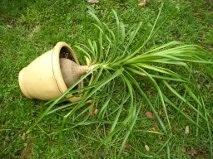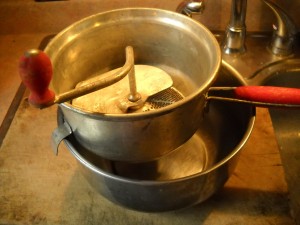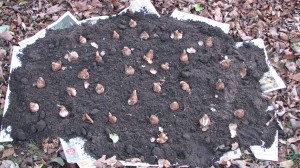Making Houseplants Happy In Winter
Making Houseplants Happy in Winter
I’m sure you’ve had the same problem I do now: aphids on your houseplants. We’ve had them outside all summer, and they never showed signs of any aphids. But bring them inside and we have those little bugs sucking their juices out (because there are no good bugs inside eating those pesky aphids). Aphids are less than a quarter of an inch long, often clear or light brown, and leave stickiness all over the leaves. What’s a person to do?
First, you should wash the plants before they move indoors. I put them on the lawn and spray them with a vigorous stream of water from the hose. Not enough to rip leaves, but a good strong spray. It is important to get both sides of the leaves washed, the stems, and the soil surface. That’s right, turn the plant on its side and spray the soil to wash off eggs or aphids lurking there.
If you have already brought in your plants, inspect them daily for signs of aphids. I know the plants that, year after year, are most susceptible to aphids. I keep them in isolation, even if I have washed them off. I love my potted Impatiens that I have on the north-facing deck all summer, and want to keep them over from one year to the next – but I know I will have aphids on them. And someone gave me a potted Meyer lemon tree – in part because it is a magnet for aphids.
Another technique to minimize aphids only works on things like rosemary, which is somewhat frost hardy: leave them outside to go through a few frosts before bringing them in. That will allow Mother Nature to kill off the aphids for you. But be careful – it’s easy to kill off plants if it gets too cold.
Then there is the “let-it-go-dormant” approach to tender plants. Many houseplants were originally from Africa or other tropical places. If they go dormant in their native country during the dry season, you can probably let them go dormant for you here. I have let my oxalis and ginger plants get completely dry for months at a time, and they come back to life when watered in the spring. They should not be kept in a warm room, however, so try to keep them at about 50 degrees, and preferably in a dark room – or in a brown paper bag.
Plants that have been outside all summer get cranky when brought inside, but you can help their attitude by providing the right amount of light and water. Too much water is a common cause of root rot and plant death or decline. Outdoors there are nice breezes to evaporate excess water in the soil, summer temperatures are warmer, and sunshine is stronger. So water only when the soil is dry to the touch an inch down. If you know your plants and pots, you can tell if water is needed just by hefting the pot.
If you have city water, it has chlorine in it, and many plants do not like chlorine. But that’s easy to fix: plan ahead. Fill a pitcher of water in the evening, and most of the chlorine will evaporate by the next night. Or you can use brook water, rain water – or heck, Perrier, if you want!
Light is another issue. The glass of your windows absorbs a lot of energy of the sun – it’s why you cannot get a tan indoors, even lying in the sun room all day with the Sunday New York Times. Sun-loving plants are the hardest to please. This year I have set up some LED lights over three of my large plants. These lights use much less energy than fluorescent lamps (28 watts to get the equivalent of 250 watts of standard incandescent light), and are sold specifically for growing plants. Mine are from Sunshine Systems (www.sunshine-systems.com or 866-576-586), their Glow Panel 45. Each panel has 112 little red or blue LED lights. I put mine on a timer so they will turn on and off automatically. They are not inexpensive, but should last for 50,000 hours. I shall see this year if that supplemental light will make a big difference to my plants.
South facing windows are best for sun-loving plants. Get your plants as close to the glass as you can, I put several pots in a big window in a rubber boot tray that I got from Gardeners Supply Company (www.gardeners.com or 888-833-1412). The tray keeps spills from getting onto the floor.
Humidity is a problem for some plants in winter, especially orchids. You can increase the moisture around your plant by putting the pot in a saucer filled with gravel. Keep water in the saucer and it will evaporate, while avoiding the problem of roots sitting in standing water, which is almost universally bad for plants.
Knowing your houseplants and what their needs are is half the battle of having nice ones. The best book I have encountered on caring for houseplants, and the specifics on individual plants is no longer in print, but is readily available in used bookstores. It’s called Making Things Grow: A Practical Guide for the Indoor Gardener by Thalassa Cruso.
If do get aphids, even after washing them outdoors, spray them with Safer Soap, a product that is safe and easy to use – or or take them with you the next time you shower!
Henry’s new book is Organic Gardening (not just) in the Northeast: A Hands-On, Month-by-Month Guide. His Web site is www.Gardening-guy.com.
The Value of Gardening
The Value of Gardening
There is, I believe, great value in gardening. I am healthier for the exercise I get gardening and for the food from it. I believe that there is a spiritual component too. I can feel at one with the world when I garden, and a connection to the generations before and after me. I can feel my grandfather (some of whose tools I still use) with me in the garden at times. And in this day and age, it makes financial sense to have a garden.
I recently chatted with Alice Elliott of Richmond, Maine. Alice is by nature a record keeper, and for the past two years she has counted, weighed and measured the produce from her garden. Her garden is not large – just a space about 20 feet by 25 feet – but in 2010 she harvested 642 pounds of veggies, with a value of $2,102.48. Each week she gets the average market price for organic vegetables from MOFGA (the Maine Organic Farmers and Gardeners Association) and, using the state average price, figures out how much her garden has earned for her.
Alice also keeps track of her expenses – seeds, potting soil, row covers, fertilizer and mulch. She has, by her own admission, “A seed habit. I can’t pass by a pretty seed packet,” she told me. She likes to try new kinds of tomatoes every year – and grows a dozen different varieties. Last year she spent $317 dollars – including an amazing $176 in seeds. One could have a much bigger garden and spend just a fraction of her seeds costs – especially if you save seeds from open pollinated plants like tomatoes and beans.
So what does Alice do with all the veggies she grows? She and her husband eat from the garden every day of the year – which means that she preserves, stores or freezes vegetables now for use when the garden no longer is producing. She has a blog that shares her garden successes (and failures) and has recipes, photos of the garden, cost/benefit analysis of the garden and more. Go to www.henbogle.com to see her garden.
Here is an interesting recipe from Alice’s blog (see her “Yankee Pantry” dropdown for others), a good one for this time of year when our gardens are winding down for the summer, but sage and other herbs are still plentiful:
Sage Butter Sauce with Parmesan
- 4 Tablespoons butter
- 20 fresh sage leaves
- 4 Tablespoons stock, broth or wine
- 5 Tablespoons grated Parmesan cheese
- Fettuccine or linguine for 4, cooked
Over medium low heat, melt butter then add sage leaves and cook until edges curl and butter is dark amber (5-6 minutes). Drain crisped sage on paper towels. Add stock and bring to a boil. Remove from heat and stir in parmesan. Serve over pasta, fresh sautéed vegetables, or roasted butternut squash; garnish with crumbled sage leaves.
One of the most important steps you can take when preparing food for winter use is to develop systems that will save you time. Alice and I agreed that doing large batches of food at once is a time saver. Buy a big blanching pot instead of a small one if you want to freeze large quantities of kale, for example. (Kale and many other veggies need to be blanched by immersing briefly in boiling water before freezing).
Alice makes lots of tomato sauce, and starts by roasting the tomatoes in a 400 degree oven for 30-50 minutes. That reduces the quantity of liquid and imparts a nice flavor, she said. She just cuts tomatoes into 2-4 chunks, and cooks them in Pyrex pans (oiled to keep the tomatoes from getting glued to the pans) until the skins turn dark and much of the moisture is gone. She then runs them through a tomato press to get rid of the seeds and skins. I found the one she uses at Gardeners Supply for about $70. I have an ancient Foley Food Mill, which does the same thing. Finally she freezes or cans the sauce – she uses a pressure cooker for canning to save time and reduce the chance of botulism. She suggests reading about botulism – a horrible illness that can be fatal – at the Web site for the National Center for Home Food Preservation at http://www.uga.edu/nchfp/how/can_home.html.
A tip I shared with Alice is that I use my grandmother’s wooden chopping board when cutting up tomatoes. It is long enough to span one of the two basins of my sink, allowing me to chop without making a mess. With a flick of the wrist I can push juice, seeds or waste into the basin of the sink, reducing mess. When making sauce, I core the tomatoes and squeeze out most of the seeds and juice before tossing them in the Cuisinart for pureeing. And I do that all right at the sink.
I’ll never be as organized as Alice. I will never count, weigh and calculate the value of the food I get from my garden, this I know. But there is great satisfaction in preparing dinner –as I did last night – using all my own ingredients. Now if I could just grow my own salt and pepper!
Henry’s new book is Organic Gardening (not just) in the Northeast: A Hands-On, Month-by-Month Guide. His Web site is www.Gardening-guy.com.
Quick Fixes for the Garden & Kitchen
Quick Fixes for the Garden and Kitchen
There is always so much to do in the garden that sometimes I can’t keep up with it all. Right now there is weeding, pruning, dividing, garden clean-up and more. So I’m always looking for ways to save time and energy. Last fall I experimented with a “Quick Fix” for planting bulbs, and I’m pleased to report it worked just fine.
For the past 30 years or so I’ve been planting bulbs each fall so that I can enjoy big punches of color in the spring. Most years I plant 100 tulips as annuals – I find that they go down hill each year, with fewer and fewer blossoms. So I buy them in bulk and don’t worry if they return, and often plant new tulips in a big bed that already has tulips. By treating them as annuals I get a great show each year – and plenty of tulips to give away.
The backbone of my bulb collection, however, is my display of daffodils – from early to late. Daffodils are foolproof. Rodents won’t eat them – they are vaguely poisonous – and deer ignore them. They will grow in full sun, but will also flower reliably in a hardwood forest. Daffodils can get enough sunshine to recharge themselves in a forest since they get a start before leaves are on the trees.
When I was a boy we had hundreds of daffies that bloomed in our woods, year after year. Eventually we had to dig them up, divide and replant with the addition of bulb booster or slow acting fertilizer. We did that because the woods had so many trees with hungry roots that eventually they needed added minerals.
But digging holes for a couple of hundred bulbs can be a lot of work. So last year I tried a new method: I simply planted them above ground and covered them with soil and compost. Here is what I did: I mowed the lawn so that the grass was very short where I planned to plant. Then I put down a thick layer of newspapers and covered that with an inch and a half of compost. I arranged bulbs on that base, pointy end up. I placed the bulbs close together in order to fit in as many as possible – they were almost touching shoulders. Then I covered the bulbs with a 50-50 mix of topsoil and compost. The directions that come with most big bulbs like tulips and daffodils suggest a 6-inch layer of soil over the tips of the bulbs. I didn’t add that much soil – it was more like 4 inches. But then I put down mulch over the fresh soil, which acted much like soil.
I didn’t write about this technique last year as I didn’t know how well it would work. I shouldn’t have worried – it was a success. My bulbs planted above ground bloomed beautifully, and this past summer I planted some annual flowers in the same soil. Next spring? Who knows how they’ll do. Until I’ve had success for a few years I only will recommend it provisionally. Rodents, for example, may find this technique to their liking – to the detriment of the bulbs.
And the mounded beds may look, to the neighbors, like grave sites. The bed I made was large enough for a dog, but if I wanted more bulbs it might raise eyebrows. I can imagine the gossip at the store: What ever happened to Henry’s crazy Aunt Mathilda, anyway?
As I clean up the garden I look for time savers, too. Instead of cutting back my hostas, I wait until we’ve had a few hard frosts. Frost will turn the leaves into mush, so instead of cutting back the plants I can pull the leaves, or just rake them up. I’ve been known to use an electric hedge trimmer to cut back big beds of phlox or other tall perennials. Hedge trimmers are fast, but require one to bend over for a long time with a machine that is considerably heavier than pruners or hedge shears. If you use electric trimmers, be sure to use a GFCI outlet for your cord. Those are the outlets with with re-set buttons to prevent your from getting hurt if you cut off your cord – which I’ve been known to do.
In the kitchen have some quick fixes, too. I freeze sliced apples in pie pans now and when they’re frozen I remove the contents and store in big zipper bags. Later, come winter, I’ll make a crust, put in those frozen apples and add the spices. They will thaw and cook in the oven, taking just a little longer to cook.
To save time I have a couple of wonderful tools for slicing apples. The first looks like a 6-inch metal wagon wheel with wire spokes. Push down on the tool and it slices an apple into 8 or 10 wedges (though the skins stay on). I have another tool that both slices and peels apples. It bolts down onto the edge of the kitchen counter, you spear an apple onto the pointy end of the machine, turn a crank, and lickety-split the apple is peeled and sliced. I found one like mine at the Vermont Country store (www.vermontcountrystore.com or 802-776-5730) for about $30.
If you have some good time savers, be sure to write me. We all need to get our chores done so we can settle into winter and relax with a good book.
Write Henry Homeyer at P.O. Box 364, Cornish Flat, NH 03746 or henry.homeyer@comcast.net or visit his Web swite www.Gardening-guy.com.





